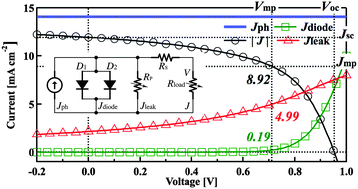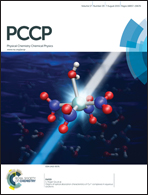Device characterization and optimization of small molecule organic solar cells assisted by modelling simulation of the current–voltage characteristics†
Abstract
In order to understand the photovoltaic performance differences between the recently reported DR3TBTT-HD and DR3TBDT2T based solar cells, a modified two-diode model with Hecht equation was built to simulate the corresponding current–voltage characteristics. The simulation results reveal that the poor device performance of the DR3TBDTT-HD based device mainly originated from its insufficient charge transport ability, where an average current of 5.79 mA cm−2 was lost through this pathway at the maximum power point for the DR3TBDTT-HD device, nearly three times as large as that of the DR3TBDT2T based device under the same device fabrication conditions. The morphology studies support these simulation results, in which both Raman and 2D-GIXD data reveal that DR3TBTT-HD based blend films exhibit lower crystallinity. Spin coating at low temperature was used to increase the crystallinity of DR3TBDTT-HD based blend films, and the average current loss through insufficient charge transport at maximum power point was suppressed to 2.08 mA cm−2. As a result, the average experimental power conversion efficiency of DR3TBDTT-HD based solar cells increased by over 40%.



 Please wait while we load your content...
Please wait while we load your content...